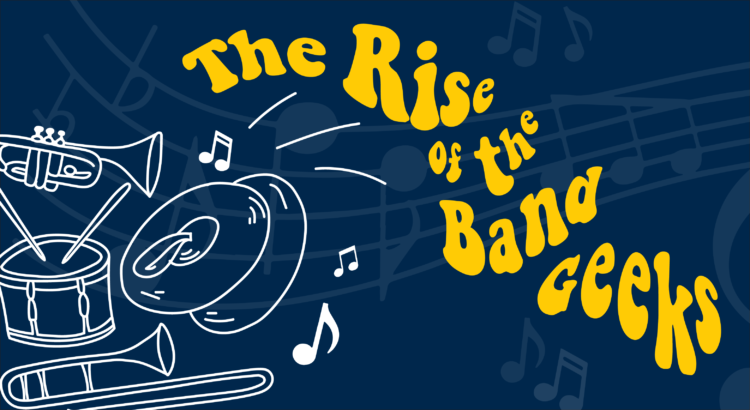
Ah, I see you’ve stumbled upon my humble abode. Welcome to the column of all things marching band, or, should I say, the column of all things marching band according to Alias. Here, you shall find short fiction and poetry centered around the theme of marching band, though for today I begin by introducing some common band terminology:
Band Director (n.) — The Fearless Leader.
Band Geek (n.) — A member of the marching band; a super cool person who may be sitting next to you in your creative writing class.
Brass (n.) — A category of instruments constituting the alto horns, euphoniums, sousaphones/tubas, trombones, and trumpets. Trumpets think they’re the heart of the band, but we all know it’s the drumline* (see below).
Drill (n.) — The set of movements constituting the actual marching part of marching band; something you should already have memorized.
Dot (n.) — The specific spot on the field you’re supposed to reach, or “make,” within a set number of counts (ie, 16 counts means you take 16 steps to get from one dot to another ); someone is said to be “on their dot” when they make said spot. It happens once in a while.
Drumline (n.) — God’s gift to marching band.
Drum Major (n.) — A rad person, usually an upperclassman, who leads and represents the marching band. Ironically, the DM is almost never a percussionist.
Flags (n.) — The section of people who dance using flags and enhance the visual effects of performances. They make it look easy, but it’s highly technical and difficult.
Field (n.) — What’s the football team doing on the band field?
Fight Song (n.) — A song, typically a march, played at sporting events to celebrate victories and generate hype. The Victors (see below) is objectively the best of these.
Marching Band (n.) — A sport that involves playing fully memorized music whilst marching around the field in perfect time while in uniform (see below); definitely not a cult.
Michigan Marching Band (MMB) (n.) — The greatest marching band in all of human history.
Michigan Stadium/The Big House (n.) — The place where over 100,000 fans gather on Saturdays to see the marching band.
Practice (v.) — What you should be doing instead of reading this glossary.
Rank (n.) — Subdivisions into twelve or so performers, each with its own leader or two; in drumline, each individual instrument is considered a rank.
Reserves (n.) — The people who did not make the performance for this week’s show; in drumline, the people who don’t play in halftime at all for the whole season.
Section (n.) — A group of people who all play the same instrument; the group of people who constitute the holy order known colloquially as the drumline. Each section has a section leader.
Shako (n.) — The epic hats band kids wear.
Show (n.) — The sweet medley of songs performed at halftime during home games.
Social Life (n.) — Never heard of it.
Temptation & War Chant (T & W) (n.) — Two glorious songs always played consecutively because, as we all know, you can’t have one without the other.
The Victors (n.) — The divinely inspired fight song wrought by Louis Elbel in 1898; the best college fight song ever written; God’s theme song. Comes in several flavors, including “As Written” and “Parking Lot Victors.”
Twirlers (n.) — A small section of cool people who twirl batons that can be attached to LED lights or even set on fire.
Uniform (n.) — The awesome getup the band wears on game days.
Woodwinds (n.) — The piccolos (pics), clarinets (sticks), and saxophones are all considered woodwinds, and often play the melody or sixteenth notes. These instruments will be damaged by the evil entity commonly known as rain.
*This information was derived from a reliable MMB trumpet alumnus the author holds in high regard.**
**The author respects the trumpet section and loves the trumpet part of “The Victors” (see above).







